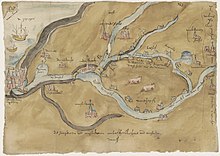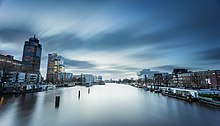The name Amstel and the older form Aemstel are derived from Amestelle, which is a compound of the words aam or ame meaning water and stelle meaning solid, high, and dry ground. In the 12th century, Amestelle was used for the area or gouw that was closed in by the rivers Amstel and Bullewijk and the bay IJ. Between the 12th and 14th centuries, the area was developed and ruled by the Van Amstel family. The river Amstel was named after this land area.
Between 1525 and 1990, the water board or hoogheemraadschap of the area through which the river flows was Amstelland (Amstel Land), a name still in use for the region. The names of the settlements Amstelhoek (Amstel Bend), Amsterdam (Amstel Dam), Nes aan de Amstel (Headland upon Amstel), and Ouderkerk aan de Amstel (Old Church upon Amstel) on the banks of the Amstel were derived from the river's name.
History

The Amstel was formed around 1050 BC when a freshwater river cut into a tidal channel of the IJ which are now Damrak and Rokin.
Course
Amstel route map | ||||||||||||||||||||||||||||||||||||||||||||||||||||||||||||||||||||||||||||||||||||||||||||||||||||||||||||||||||||||||||||||||||||||||||||||||||||||||||||||||||||||||||||||||||||||||||||||||||||||||||||||||||||||||||||||||||||||||||||||||||||||||||||||||||||||||||||||||||||||||
|---|---|---|---|---|---|---|---|---|---|---|---|---|---|---|---|---|---|---|---|---|---|---|---|---|---|---|---|---|---|---|---|---|---|---|---|---|---|---|---|---|---|---|---|---|---|---|---|---|---|---|---|---|---|---|---|---|---|---|---|---|---|---|---|---|---|---|---|---|---|---|---|---|---|---|---|---|---|---|---|---|---|---|---|---|---|---|---|---|---|---|---|---|---|---|---|---|---|---|---|---|---|---|---|---|---|---|---|---|---|---|---|---|---|---|---|---|---|---|---|---|---|---|---|---|---|---|---|---|---|---|---|---|---|---|---|---|---|---|---|---|---|---|---|---|---|---|---|---|---|---|---|---|---|---|---|---|---|---|---|---|---|---|---|---|---|---|---|---|---|---|---|---|---|---|---|---|---|---|---|---|---|---|---|---|---|---|---|---|---|---|---|---|---|---|---|---|---|---|---|---|---|---|---|---|---|---|---|---|---|---|---|---|---|---|---|---|---|---|---|---|---|---|---|---|---|---|---|---|---|---|---|---|---|---|---|---|---|---|---|---|---|---|---|---|---|---|---|---|---|---|---|---|---|---|---|---|---|---|---|---|---|---|---|---|---|---|---|---|---|---|---|---|---|---|---|---|---|---|---|---|
| ||||||||||||||||||||||||||||||||||||||||||||||||||||||||||||||||||||||||||||||||||||||||||||||||||||||||||||||||||||||||||||||||||||||||||||||||||||||||||||||||||||||||||||||||||||||||||||||||||||||||||||||||||||||||||||||||||||||||||||||||||||||||||||||||||||||||||||||||||||||||
Sources
The Amstel begins where the canal Aarkanaal and the river Drecht meet, just north of the village Nieuwveen in the province of South Holland. Here the river forms the border between the provinces of South Holland and North Holland and flows in northeastern direction.
Amstelland

The Amstel passes the hamlet Vrouwenakker and is then joined by the tributary river Kromme Mijdrecht. On the northern bank is the town Uithoorn and on the southern bank is the village Amstelhoek. Here the river forms the border between the provinces of Utrecht and North Holland.
Further on, the river is joined by the tributary river Oude Waver. From here onwards, the river flows northward through the province of North Holland. The Amstel passes the village Nes aan de Amstel.
On the western bank is the town Amstelveen, where there is a small island in the river named Amsteleiland, and on the eastern bank the town of Ouderkerk aan de Amstel, where the river is joined by the tributary river Bullewijk. After this the Amstel flows into the city of Amsterdam.
Amsterdam

In Amsterdam, the canals Duivendrechtsevaart and Weespertrekvaart are tributaries to the Amstel. There are several historical bridges crossing the river, among which are the Berlagebrug, Magere Brug, and Blauwbrug.
In the city center, the river is connected to several city canals, which are a UNESCO World Heritage Site. The Amstel Hotel, Royal Theater Carré, H'ART Museum, city hall in the Stopera, and Allard Pierson Museum are located on the eastern bank of the river.
The river continues via the Rokin to the Langebrugsteeg before being routed underground through pipes, passing under the filled in part of the Rokin and Dam Square before remerging into the Damrak at the Oudebrugsteeg. The river then passes beneath the Prins Hendrikkade before empyting into the Open Havenfront.
Mouth
The original course continues with Damrak, after which it passes Stationseiland, an artificial island with Amsterdam Centraal station, and flows into the former bay IJ.
Cultural events
A nationally televised concert is held on the river every year on Liberation Day. The rowing races Head of the River Amstel and Heineken Roeivierkamp are held on the river annually. The river also forms part of the route of the Canal Parade, Amsterdam's annual floating gay pride parade.
Artist impressions

The river has been depicted by many artists, including:
- Aert van der Neer (1603–1677)
- Rembrandt (1609–1669)
- Willem Witsen (1860–1923)
- George Hendrik Breitner (1857–1923)
- Piet Mondrian (1872–1944)
References
- ^ Ahmed, Shamim (10 July 2015). "Amsterdam • Venice of the North". theindependentbd.com. The Independent. Archived from the original on 15 June 2022. Retrieved 15 June 2022.
- ^ "Amstel" (in Dutch), Woordenboek der Nederlandsche Taal, 1889/2007. Retrieved on 29 October 2020.
- ^ G. van Berkel & K. Samplonius, "Amsterdam (Amsterdam, NH)" (in Dutch), Nederlandse plaatsnamen verklaard, 2018. Retrieved on 10 October 2020.
- ^ "Nederlandsche plaatsnamen" (in Dutch), Onze Taal, 1942. Retrieved on 29 October 2020.
- ^ "De geschiedenis van Amsterdam" (in Dutch), Municipality of Amsterdam. Retrieved on 29 October 2020.
- ^ "1200-1585: de voorgeschiedenis. De Heren van Aemstel" (in Dutch), Municipality of Amsterdam. Retrieved on 29 October 2020.
- ^ "Stamboom met schematische voorstelling van opgeheven vroeger zelfstandige besturen van rechtsvoorgangers in het werkgebied van hoogheemraadschap Amstel, Gooi en Vecht" (in Dutch), Historisch archief van Waterschap Amstel, Gooi en Vecht, 2007. Retrieved on 29 October 2020.
- ^ G. van Berkel & K. Samplonius, "Amstelhoek (De Ronde Venen, U)" (in Dutch), Nederlandse plaatsnamen verklaard, 2018. Retrieved on 23 October 2020.
- ^ G. van Berkel & K. Samplonius, "Nes aan de Amstel (Amstelveen, NH)" (in Dutch), Nederlandse plaatsnamen verklaard, 2018. Retrieved on 23 October 2020.
- ^ G. van Berkel & K. Samplonius, "Ouderkerk aan de Amstel (Amstelveen, NH)" (in Dutch), Nederlandse plaatsnamen verklaard, 2018. Retrieved on 23 October 2020.
- ^ Jerzy Gawronski & Peter Kranendonk, "The River Amstel", Municipality of Amsterdam. Retrieved on 1 November 2020.
External links
 Media related to Amstel at Wikimedia Commons
Media related to Amstel at Wikimedia Commons

